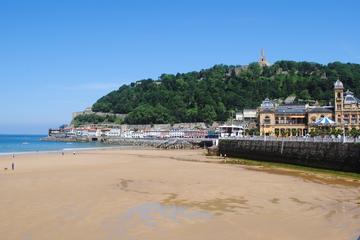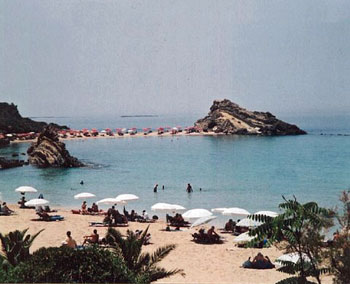
by W. Ruth Kozak
The Ionian Islands of Greece’s west coast, have inspired poets like Homer, Sappho, Cavafy and Lord Byron. The sea here is so transparent you can see straight into the depths. The wind has eroded the shoreline to form sheer cliffs and extraordinary caves where once pirates lurked and often hid their treasures. The pale, platinum clear water, still as enamel one moment, can turn into a raging tempest when the wind shifts.
Kefalonia is the largest and most mountainous of the islands. Its coast forms steep cliffs and small bays with magnificent, wind-protected beaches. Pretty villages of pastel stone houses cluster around the curves of sandy bays. Little coves that used to shelter pirate galleons and Venetian merchant ships are harbors for yachts from all over the world. Resort hotels dot the shoreline, especially near the gold sand beaches of Platia Gialos and Poros.
Kefalonia has often been visited by famous people, most notably the poet Lord Byron, who often came here to enjoy the scenery. In the village of Metaxata, there’s a plaque on the house where he stayed just before he went off to Missolonghi to fight the Turks, and later died of pneumonia.
British author Louis de Bernieres, made the island of Kefalonia famous with his best selling novel “Captain Corelli’s Mandolin”, about a young Italian officer posted to the island as one of the occupying forces during W.W.II.
 As I watched the glorious sunset from the Venetian-style lighthouse, Fenari, I contemplated the many tragedies that have befallen this beautiful island.
As I watched the glorious sunset from the Venetian-style lighthouse, Fenari, I contemplated the many tragedies that have befallen this beautiful island.
In 1953 Kefalonia was devastated by an earthquake, which ruined most of its villages. Almost all the architecture on the island is post-earthquake. The elegant opera house and Venetian-style mansions of Argostoli and Lixouri no longer exist. Here and there on the island lie ruins of destroyed houses, a reminder of the disaster.
At the northern tip of the island is the lovely little town of Fiskardo. It used to be a port of shelter for a Norman pirate named Robert Guiscard, for whom the town is named. On the headland are the ruins of two Venetian lighthouses and a twelfth-century chapel that is believed to have been started by Guiscard.
From Kefalonia, it’s only a short cruise by ferry over to Ithaka, the small island featured in Homer’s “Odyssey” as the kingdom of the extreme adventurer Odysseus.
A brisk breeze ruffled the water as I watched the dark mountains of Ithaka draw near across the narrows. The boat pulled into one of Ithaka’s secret coves. The port is shaped like a horseshoe. In the centre is a tiny island where a charming seaman’s chapel is surrounded by cypresses. Lord Byron, who often visited Ithaka, used to row out to it each morning to swim.
 The harbor of Vathi is surrounded by houses with red-tiled roofs. Cafes animate the waterfront. The summer evening is scented with the smoke of grilling kebabs and fresh-caught fish grilling over charcoal coals. There is a curious atmosphere here. Ithaka’s hillsides are scented with wild sage and oregano, dotted with vibrant wild-flowers and silvery olive groves. Surrounding the tranquil orchards and vineyards are the high menacing mountains.
The harbor of Vathi is surrounded by houses with red-tiled roofs. Cafes animate the waterfront. The summer evening is scented with the smoke of grilling kebabs and fresh-caught fish grilling over charcoal coals. There is a curious atmosphere here. Ithaka’s hillsides are scented with wild sage and oregano, dotted with vibrant wild-flowers and silvery olive groves. Surrounding the tranquil orchards and vineyards are the high menacing mountains.
The main port of Vathi is situated on a pretty bay. Most of the old town was destroyed in the earthquake of 1953 and there are still a few examples of pre-quake architecture.
I visited the Cave of the Nymphs where a team of American archaeologists and students are busy sifting and sorting through rubble brought up from a ten-meter pit. This cave is believed to be the one where Odysseus hid the gifts given to him by the Phaecians when he returned home after his long, arduous voyage. Later, on our way to the town of Stavros, I passed the rock-strewn remains of what is believed to be the Bronze Age city.
 It’s an Odyssey in itself just getting off Ithaka. The taxi picked me up as scheduled in order to make the sailing to Lefkada. I enjoyed the scenic drive and arrive in plenty of time, but fifteen minutes before the ferry was due to arrive, I discovered that the ferry that had broken down, and we must leave from a different port. After a hair-raising wild race by taxi on a twisting road with hairpin curves and precipices, I arrived at the port just minutes before the ferry sailed.
It’s an Odyssey in itself just getting off Ithaka. The taxi picked me up as scheduled in order to make the sailing to Lefkada. I enjoyed the scenic drive and arrive in plenty of time, but fifteen minutes before the ferry was due to arrive, I discovered that the ferry that had broken down, and we must leave from a different port. After a hair-raising wild race by taxi on a twisting road with hairpin curves and precipices, I arrived at the port just minutes before the ferry sailed.
A school of dolphins frolicked in the surf alongside the ferry as we sailed toward the high sandstone cliffs of Lefkada’s south coast. I disembarked at the pleasant little port of Vassiliki, a popular centre for wind-surfers. Hundreds of brightly colored sails skimmed like butterflies over the surface of the Bay. Wind surfers come here from all over Europe.
The next day, I went on a boat cruise around the Cape known as “Sappho’s Leap” where the poet Sappho committed suicide back in 600 BC.
 Sailing past Cape Doukas, the towering white cliffs rise from a sea that is as blue as a robin’s egg. The Cape looks like a gigantic wedge of cake with a lighthouse on top for a candle.
Sailing past Cape Doukas, the towering white cliffs rise from a sea that is as blue as a robin’s egg. The Cape looks like a gigantic wedge of cake with a lighthouse on top for a candle.
The boat anchored at idyllic Egremeni Beach and we scrambled down steep ladders to the shore. I had brought a picnic lunch and a book of Sappho’s love poems and lay on the beach listening to the waves crackle on the pebble shore. As I looked up at those high cliffs from where she plunged, I read her haunting words: “About the cool water, the wind sounds through sprays…”
I extended my visit to Lefkada when I saw an advertisement for another excursion. “Islands Panorama” promised to include Onassis’ island, Skorpios, the island of Madouri, home of Greek national poet Valaortes, and Meganissi, an island famous for its sea caves.
Our first stop was the Cave of Papanikolis. The boat navigated carefully around submerged rocks and entered the mysterious blue cavern. I was surprised to see that there was already another boat inside. I imagined the cave as a pirate’s hideaway.
On the way to the next island stop, we chased a school of dolphins around in circles in the Bay. Dolphins are a rare sight because the fishers, who claim they damage their nets, are killing them. But here in the Ionian Sea there seems to be an abundance, and they are a joy to watch as they splash and dive through the boat’s wake.
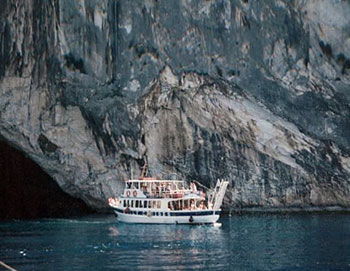 The boat circled the island of Skorpios, a small island, densely wooded with cypress and pine trees. The red-tiled roofs of the Onassis’ villas are half-hidden behind the trees. In each little cover there are piers, each with a palm tree planted at the end. Around the dock areas, the grounds are landscaped and showers of magenta bougainvillea spill over the stone fences. One of these villas was a gift to opera singer Maria Callas in the days before Onassis abandoned her in favor of Jacqueline Kennedy.
The boat circled the island of Skorpios, a small island, densely wooded with cypress and pine trees. The red-tiled roofs of the Onassis’ villas are half-hidden behind the trees. In each little cover there are piers, each with a palm tree planted at the end. Around the dock areas, the grounds are landscaped and showers of magenta bougainvillea spill over the stone fences. One of these villas was a gift to opera singer Maria Callas in the days before Onassis abandoned her in favor of Jacqueline Kennedy.
We were allowed to disembark to swim at a small pebble beach secluded by a thick stand of myrtle bushes. Cicadas trill in the pine trees. As I paddled in the clear, turquoise water, I thought of how not long ago, Jackie O and her children had swam there. So did Maria Callas. And once Princess Diana and her lover Dodi Fayez cruised and frolicked in those same waters.
Skorpios is a symbol of the Rich and Famous, Onassis’ private Garden of Eden. Yet it’s a strange, tragic paradise, with nobody left to enjoy it but Onassis’ granddaughter, Athena, said to be the richest girl in the world.
We cruised away from Skorpios and skirted around the smaller islands, with a stop for a swim at Agiofili Beach. The whole day was a delightful island experience. I not only followed the path of poets and ancient adventurers, I even went swimming where the rich and famous once swam.
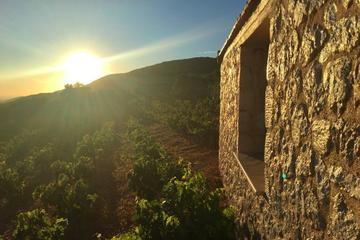
Private Tour: Kefalonia Wine Discovery with Gastronomic or Picnic Lunch
If You Go:
To Kefalonia:
- Buses leave the Kifissou Avenue depot in Athens several times a day for the ports of Sami, Argostoli, Lixouri and Poros, via the ferry from Patras. Trip takes 8 hours. Approx. $35 one way.
- Olympic Airways domestic flights are available as well as charter direct from Britain.
- Hotels and pensions throughout the island accommodate travelers. An island bus provides service to any of the scenic villages and beaches. From Argostoli, take the commuter ferry to Lixouri.
- Car and moped rentals are also available.
- Camp sites are located at Argostoli and Sami.
To Ithaka:
- Ferries run daily from the port of Patras, or neighboring islands Kefalonia and Lefkada.
- Buses run daily from Athens Kifissou Avenue depot, connecting with the ferry at Patras.
- Accommodations are available in private homes and hotels on Ithaka.
- No camping is allowed.
To Lefkada:
- You can reach Lefkada by car or bus as the island is connected to the mainland at the northern point by a bridge.
- Buses run daily from the Athens Kifissou Avenue. Depot.
- If you’re island hopping you can go by ferry from Kefalonia (Fiskardo) or Ithaka to Vassiliki.
- At Vassiliki there is accommodation in pensions, hotels and a campsite is located near the wind-surf beach.
About the author:
Ruth has always enjoyed Homer’s tales of adventure, and this journey, like others she has made to Troy, was a chance to follow Odysseus travels. Ruth is a historical fiction writer, travel journalist, playwright and poet, so visiting these places connected to other writers and poets made this trip extra special. See her website at www.ruthkozak.com
All photographs are by W. Ruth Kozak.

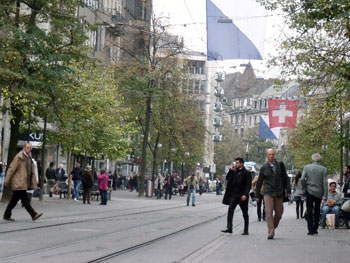
 Because the Swiss are known for their quality chocolate making, and combined with my passion for the confection, it was on my agenda to check out some of the shops, nestled among other outlets selling high line fashions, watches, and jewelry. Two chocolate shops, Confiserie Sprungli and Teuscher produced a hearty scent of cocoa that pleasantly flowed through my nostrils. It was a chocolate feast for my eyes, as meticulously-decorated items with such names like Pariser-Konfekt and Gianduia-Rustica lined the shelves of delights, many of which are handmade at Confiserie Sprungli.. Even though chocolate prices range around $50 a pound here, one can keep things more budget-friendly by purchasing the treats in 100 gram increments (around 3.5 oz).
Because the Swiss are known for their quality chocolate making, and combined with my passion for the confection, it was on my agenda to check out some of the shops, nestled among other outlets selling high line fashions, watches, and jewelry. Two chocolate shops, Confiserie Sprungli and Teuscher produced a hearty scent of cocoa that pleasantly flowed through my nostrils. It was a chocolate feast for my eyes, as meticulously-decorated items with such names like Pariser-Konfekt and Gianduia-Rustica lined the shelves of delights, many of which are handmade at Confiserie Sprungli.. Even though chocolate prices range around $50 a pound here, one can keep things more budget-friendly by purchasing the treats in 100 gram increments (around 3.5 oz). Switzerland is one of the most expensive countries in the world to visit, but ironically, Zurich gives away one of the most important staples of life: water, via its 1,200 public fountains that dispense the crystal clear liquid (my taste buds noticed no chemical taste) from unique statues that have needles on top of them so as to keep pigeons away. I couldn’t help but notice St. Peter’s church, one of the conspicuous landmarks of the area, for its 28 foot in diameter clock face, the largest in Europe. I wanted a nice vantage point of the Old City, and got it a few blocks north at the Lindenhof. It’s called that because of the Linden trees that dominate the park area that overlooks the river, offering great views of the Old Town. It’s the highest point of the Old City that dates back to pre-Roman times, when the Celtic Helvetti resided here. Across the river, I spotted the double Neo-Gothic domes of the towers of the Grossmuenster, which dates back to the 12th century, and where the Reformation began in the country.
Switzerland is one of the most expensive countries in the world to visit, but ironically, Zurich gives away one of the most important staples of life: water, via its 1,200 public fountains that dispense the crystal clear liquid (my taste buds noticed no chemical taste) from unique statues that have needles on top of them so as to keep pigeons away. I couldn’t help but notice St. Peter’s church, one of the conspicuous landmarks of the area, for its 28 foot in diameter clock face, the largest in Europe. I wanted a nice vantage point of the Old City, and got it a few blocks north at the Lindenhof. It’s called that because of the Linden trees that dominate the park area that overlooks the river, offering great views of the Old Town. It’s the highest point of the Old City that dates back to pre-Roman times, when the Celtic Helvetti resided here. Across the river, I spotted the double Neo-Gothic domes of the towers of the Grossmuenster, which dates back to the 12th century, and where the Reformation began in the country.
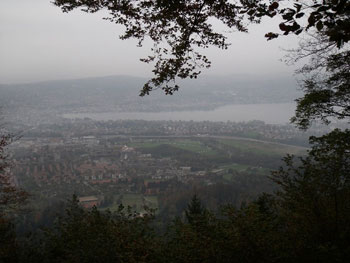 The beauty of a place truly shows through, not when the weather is picture perfect with the sun a blazing, but when the weather isn’t ideal, as was the case with my ascent to Uetliberg to get a bird’s eye view of the area. Once again, with my Swiss Pass, I was able to take a 22 or so minute commuter train ride from the Hauptbahnhof (Tracks 1 or 2) to the base, taking in chalet homes, green soccer pitches, and Switzerland’s own brand of autumn foliage that complimented the greenway paths along the tracks. From the station above, I proceed upwards for about ten minutes on dirt paths “beautifully-littered” with fallen red, green, brown, orange, and yellow foliage. As I ascended the mountain top, I noticed tall giraffe-like figurines whose antlers serve as lights. There are numerous hiking and biking paths that cut through lush greenery that makes getting lost a pleasant experience.
The beauty of a place truly shows through, not when the weather is picture perfect with the sun a blazing, but when the weather isn’t ideal, as was the case with my ascent to Uetliberg to get a bird’s eye view of the area. Once again, with my Swiss Pass, I was able to take a 22 or so minute commuter train ride from the Hauptbahnhof (Tracks 1 or 2) to the base, taking in chalet homes, green soccer pitches, and Switzerland’s own brand of autumn foliage that complimented the greenway paths along the tracks. From the station above, I proceed upwards for about ten minutes on dirt paths “beautifully-littered” with fallen red, green, brown, orange, and yellow foliage. As I ascended the mountain top, I noticed tall giraffe-like figurines whose antlers serve as lights. There are numerous hiking and biking paths that cut through lush greenery that makes getting lost a pleasant experience. Even though Zurich West is a just a few minutes away from the Haptbahnhof by numerous S-Bahnen commuter trains to Hardbrucke station (including the S9) or around ten minutes by tram, it was as if I stepped out into a totally different world. After disembarking, I noticed I was close to 415 foot high modern skyscraper called the Prime Tower. It’s a world that’s a cross between a post-modern and old Communist-style city mixed uniquely with new ideas in design that cherishes the old remnants of Zurich’s past going back two centuries. This area was once made up of factories and foundries that produced soap, various mechanical parts, etc. In the early 1990s, Zurich West began to revitalize itself, using the skeletons of its industrial past as a basis for what it is today, a bustling multi-cultural melting pot containing trendy clubs and bars with names like “Supermarket”, retail and second hand shops (there’s a nicely-stocked Salvation Army thrift store that’s called “Heils-Armee”), and offices full of white collar workers glued to their laptops.
Even though Zurich West is a just a few minutes away from the Haptbahnhof by numerous S-Bahnen commuter trains to Hardbrucke station (including the S9) or around ten minutes by tram, it was as if I stepped out into a totally different world. After disembarking, I noticed I was close to 415 foot high modern skyscraper called the Prime Tower. It’s a world that’s a cross between a post-modern and old Communist-style city mixed uniquely with new ideas in design that cherishes the old remnants of Zurich’s past going back two centuries. This area was once made up of factories and foundries that produced soap, various mechanical parts, etc. In the early 1990s, Zurich West began to revitalize itself, using the skeletons of its industrial past as a basis for what it is today, a bustling multi-cultural melting pot containing trendy clubs and bars with names like “Supermarket”, retail and second hand shops (there’s a nicely-stocked Salvation Army thrift store that’s called “Heils-Armee”), and offices full of white collar workers glued to their laptops. As I walked on the wide walkways among the edifices, I took in such bizarre sights as the the Freitag shop which uses 19 old shipping crates stacked nine stories high to sell handbags and wallets made out of recycled industrial components. And down the street, the outlets in a strip mall called Im Viadukt are nestled inside the arches of a railroad bridge that was built in the late 1800s.
As I walked on the wide walkways among the edifices, I took in such bizarre sights as the the Freitag shop which uses 19 old shipping crates stacked nine stories high to sell handbags and wallets made out of recycled industrial components. And down the street, the outlets in a strip mall called Im Viadukt are nestled inside the arches of a railroad bridge that was built in the late 1800s.
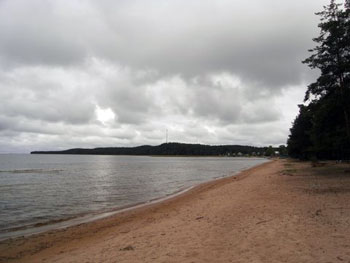
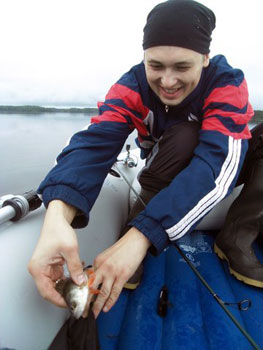 I could stay on its shores for ages, admiring its mirror-surface and abundant vegetation but we had plenty things to do. It was already 4 p.m. when we arrived. Hungry sick and tired after a long trip we had to pitch tents while others sought firewood and cooked dinner. It was rather complicated to find dry firewood as soil was damp and mossy. Trees covered with lichen were demi-rotten. Fortunately my husband Vadim found a huge fallen birch that was dry enough to make fire.
I could stay on its shores for ages, admiring its mirror-surface and abundant vegetation but we had plenty things to do. It was already 4 p.m. when we arrived. Hungry sick and tired after a long trip we had to pitch tents while others sought firewood and cooked dinner. It was rather complicated to find dry firewood as soil was damp and mossy. Trees covered with lichen were demi-rotten. Fortunately my husband Vadim found a huge fallen birch that was dry enough to make fire.
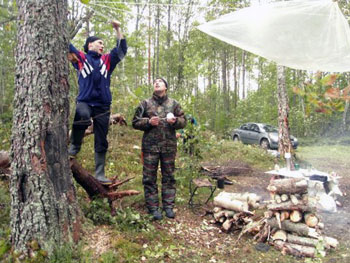 Despite our hopes and expectations, rain didn’t stop and wind became even more furious, making trees swing from side to side.
Despite our hopes and expectations, rain didn’t stop and wind became even more furious, making trees swing from side to side. For a moment we kept silence. Wind gained strength. It started to snow, although it was July. I didn’t expect it would be so cold and windy. Shivering with cold I offered others to fish on the lake bank hidden in thick vegetation. As it turned out the idea was great. Our friends who preferred to stay near fire were chilled to the bone as we returned with our modest catch. It is that we set up our tents and made fire in the forest edge winded from every side. Hard wind and rain turned our fire into smoldering coals. Three perches and two roaches we managed to catch made a fragrant and tasty hot fish soup that warmed us up and filled with energy. Our joy didn’t last long. The hot tea Vadim boiled on a bonfire became cold in a few minutes. There was no hope that the weather would improve. Severe wind almost blew out our fire. It started to hail. Trees were swinging in the strong wind threatening to fall down. It became clear that we would have to spend the whole night in fragile tents under huge trees. The idea to spend night under the Sword of Damocles frightened Kristina so much that she pledged us to drive away as soon as possible. It was already 2 a.m. It would take at least two hours to pack two tents and a boat in the darkness of Karelian night lightened by two tourist lanterns. There was no choice. The only thing we could do is to go to bed.
For a moment we kept silence. Wind gained strength. It started to snow, although it was July. I didn’t expect it would be so cold and windy. Shivering with cold I offered others to fish on the lake bank hidden in thick vegetation. As it turned out the idea was great. Our friends who preferred to stay near fire were chilled to the bone as we returned with our modest catch. It is that we set up our tents and made fire in the forest edge winded from every side. Hard wind and rain turned our fire into smoldering coals. Three perches and two roaches we managed to catch made a fragrant and tasty hot fish soup that warmed us up and filled with energy. Our joy didn’t last long. The hot tea Vadim boiled on a bonfire became cold in a few minutes. There was no hope that the weather would improve. Severe wind almost blew out our fire. It started to hail. Trees were swinging in the strong wind threatening to fall down. It became clear that we would have to spend the whole night in fragile tents under huge trees. The idea to spend night under the Sword of Damocles frightened Kristina so much that she pledged us to drive away as soon as possible. It was already 2 a.m. It would take at least two hours to pack two tents and a boat in the darkness of Karelian night lightened by two tourist lanterns. There was no choice. The only thing we could do is to go to bed.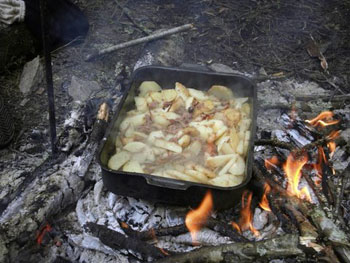 When I zipped my tent from the inside, I felt myself like a small insect caught by hail under a fragile leaf. I saw nothing but darkness in my small tent, although noises and howls made it clear that huge trees were swung and thrashed severely in the thundering wind as if they were ears of wheat. In spite of my anxiety I slept like a baby after active day in nature. As we got up the weather didn’t changed for the best, on the contrary it became even colder. It was time we left. One may think that it’s a pleasure to leave stormy, rainy and hostile place for cozy armchair in your sweet home. It depends on the person. Karelia is not sunny and friendly most of the days. It can be rather rigorous and austere. Nevertheless it recharges you with vital energy, makes one strive for life, be grateful for small favors made by nature and notice sun even during rainy days.
When I zipped my tent from the inside, I felt myself like a small insect caught by hail under a fragile leaf. I saw nothing but darkness in my small tent, although noises and howls made it clear that huge trees were swung and thrashed severely in the thundering wind as if they were ears of wheat. In spite of my anxiety I slept like a baby after active day in nature. As we got up the weather didn’t changed for the best, on the contrary it became even colder. It was time we left. One may think that it’s a pleasure to leave stormy, rainy and hostile place for cozy armchair in your sweet home. It depends on the person. Karelia is not sunny and friendly most of the days. It can be rather rigorous and austere. Nevertheless it recharges you with vital energy, makes one strive for life, be grateful for small favors made by nature and notice sun even during rainy days.
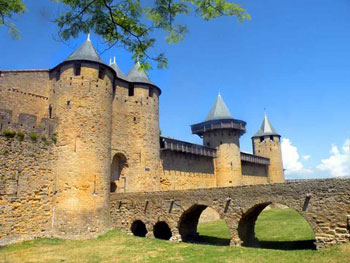
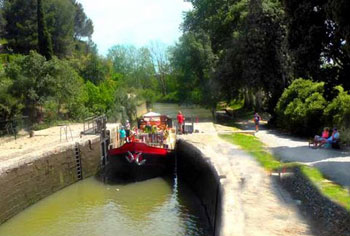 The captain and deckhand swiftly dismantle the roof and windows of our boat’s raised wheelhouse as an ancient stone bridge comes into view. We crouch and duck our heads; the vessel just barely fits underneath. Beyond, the boat slips serenely along on a ribbon of green under a shady canopy of plane trees. At the occasional break in the foliage, we spot a tall church spire, sprawling vineyards and the distant snowy peaks of the Pyrenees. Our captain will not need to replace the wheelhouse for days to come. It is May, and the weather remains blissfully warm and dry. Welcome to the Canal du Midi, which crosses Languedoc in the sunny South of France.
The captain and deckhand swiftly dismantle the roof and windows of our boat’s raised wheelhouse as an ancient stone bridge comes into view. We crouch and duck our heads; the vessel just barely fits underneath. Beyond, the boat slips serenely along on a ribbon of green under a shady canopy of plane trees. At the occasional break in the foliage, we spot a tall church spire, sprawling vineyards and the distant snowy peaks of the Pyrenees. Our captain will not need to replace the wheelhouse for days to come. It is May, and the weather remains blissfully warm and dry. Welcome to the Canal du Midi, which crosses Languedoc in the sunny South of France.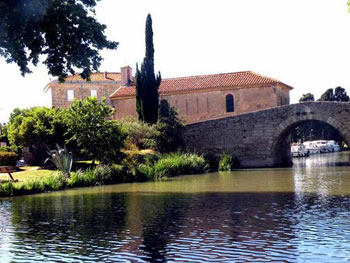 We arrive in the town of Beziers on the 330th anniversary of the canal’s official opening. Gala concerts, sound and light shows, and fireworks mark the event. With narrow cobblestone streets, a beautiful hillside park, and inviting little outdoor restaurants, Beziers is the birthplace of Pierre-Paul Riquet, the genius who conceived and spearheaded the 150-mile long canal project, beginning in the 1660s. The goal was to link the Atlantic with the Mediterranean, thereby avoiding the dangerous journey around Spain and past the fierce Barbary pirates. Its design is unlike most other canals, in France and elsewhere, which are excavated trenches that generally follow natural river valleys and draw their water supply from those rivers. The Canal du Midi follows the contours of hillsides and crosses right over natural features like rivers and streams on the raised archways of elegant stone aqueducts. Its source of water is a large mountain reservoir. Near Beziers, the canal leaps up a steep stone “staircase” of nine consecutive locks and later tunnels through a low mountain. A 17th century engineering marvel.
We arrive in the town of Beziers on the 330th anniversary of the canal’s official opening. Gala concerts, sound and light shows, and fireworks mark the event. With narrow cobblestone streets, a beautiful hillside park, and inviting little outdoor restaurants, Beziers is the birthplace of Pierre-Paul Riquet, the genius who conceived and spearheaded the 150-mile long canal project, beginning in the 1660s. The goal was to link the Atlantic with the Mediterranean, thereby avoiding the dangerous journey around Spain and past the fierce Barbary pirates. Its design is unlike most other canals, in France and elsewhere, which are excavated trenches that generally follow natural river valleys and draw their water supply from those rivers. The Canal du Midi follows the contours of hillsides and crosses right over natural features like rivers and streams on the raised archways of elegant stone aqueducts. Its source of water is a large mountain reservoir. Near Beziers, the canal leaps up a steep stone “staircase” of nine consecutive locks and later tunnels through a low mountain. A 17th century engineering marvel.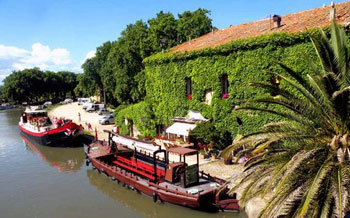 Captain Uli Weber picks us up at our hotel, along with our Australian companions Jan Kenchington and Janette Frost, and drives us west out of Beziers to join Caroline, which we have booked through FranceCruises.com. Built in the 1920s as a classic Dutch sailing barge, the boat is brightly painted with graceful hull lines, upswept both fore and aft, and a broad, spacious main deck. We are greeted by Uli’s wife Ute, who takes us below and shows us to our well-appointed cabins.
Captain Uli Weber picks us up at our hotel, along with our Australian companions Jan Kenchington and Janette Frost, and drives us west out of Beziers to join Caroline, which we have booked through FranceCruises.com. Built in the 1920s as a classic Dutch sailing barge, the boat is brightly painted with graceful hull lines, upswept both fore and aft, and a broad, spacious main deck. We are greeted by Uli’s wife Ute, who takes us below and shows us to our well-appointed cabins.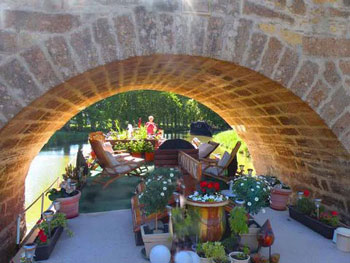 Caroline, however, is a much smaller and more intimate boat. Uli and Ute are the owners. They live aboard year-round and do everything themselves, which allows them to charge considerably less. He pilots the barge, is waiter at mealtimes, and serves as driver and highly knowledgeable guide during side trips in their mini-van. She is the five-star chef, with 250 cookbooks in her collection, as well as chambermaid and deckhand while docking or going through locks. From the first moments, we feel ourselves to be guests in a lovingly decorated home. It is an informal space that is planted with on-deck flower beds and studded with cushioned deck chairs, zany wooden sculptures, even a tiny pond full of fishes and water lilies. Although there is a cozy salon below, with a dining table, sofas and a wood-burning fireplace, we are favoured by good weather and take most meals up on deck.
Caroline, however, is a much smaller and more intimate boat. Uli and Ute are the owners. They live aboard year-round and do everything themselves, which allows them to charge considerably less. He pilots the barge, is waiter at mealtimes, and serves as driver and highly knowledgeable guide during side trips in their mini-van. She is the five-star chef, with 250 cookbooks in her collection, as well as chambermaid and deckhand while docking or going through locks. From the first moments, we feel ourselves to be guests in a lovingly decorated home. It is an informal space that is planted with on-deck flower beds and studded with cushioned deck chairs, zany wooden sculptures, even a tiny pond full of fishes and water lilies. Although there is a cozy salon below, with a dining table, sofas and a wood-burning fireplace, we are favoured by good weather and take most meals up on deck.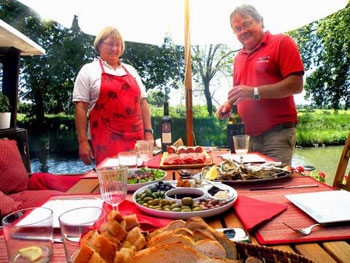 For guests who prefer to sample the many interesting canal-side eateries, the Caroline cruises offer a lower priced half-board option. Guests take breakfast and a large lunch on board but eat most dinners in nearby restaurants at their own expense. We do this one night and enjoy an excellent dinner with wine at a classic auberge within easy staggering distance of the moored barge. Another variation is to have lunch in a market restaurant during a side trip, or to select and bring back the fixings for a picnic lunch or a barbecue on board the boat. Uli and Ute are flexible and open to all suggestions. One side trip takes us to the morning market in a nearby town, where Uli invites us to select anything we want him to purchase for our lunch. There are at least 25 kinds of olives, prepared in different ways, and an amazing assortment of cheeses and dry salamis, with each vendor offering taste tests. I am eager to try the Mediterranean oysters, and Uli knows just who has the best shellfish. Back on board, Ute serves me half of them raw, and they are the freshest and most succulent I have ever eaten. The rest she grills lightly with Parmesan cheese and parsley for the others to taste. They are sublime.
For guests who prefer to sample the many interesting canal-side eateries, the Caroline cruises offer a lower priced half-board option. Guests take breakfast and a large lunch on board but eat most dinners in nearby restaurants at their own expense. We do this one night and enjoy an excellent dinner with wine at a classic auberge within easy staggering distance of the moored barge. Another variation is to have lunch in a market restaurant during a side trip, or to select and bring back the fixings for a picnic lunch or a barbecue on board the boat. Uli and Ute are flexible and open to all suggestions. One side trip takes us to the morning market in a nearby town, where Uli invites us to select anything we want him to purchase for our lunch. There are at least 25 kinds of olives, prepared in different ways, and an amazing assortment of cheeses and dry salamis, with each vendor offering taste tests. I am eager to try the Mediterranean oysters, and Uli knows just who has the best shellfish. Back on board, Ute serves me half of them raw, and they are the freshest and most succulent I have ever eaten. The rest she grills lightly with Parmesan cheese and parsley for the others to taste. They are sublime.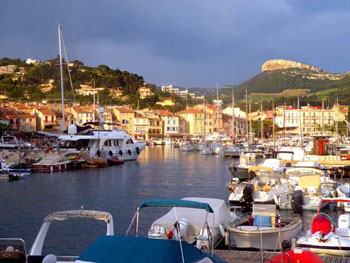 Most side trips, however, are focused on more than food. Languedoc is rich in historical sites. In Narbonne, we view a small excavated section of the Via Domitia, the ancient road that linked Rome with Spain. Hannibal probably passed this way with his elephants to attack Rome in 218 B.C. We tour the fortified hilltop village of Minerve. A little museum with dioramas tells the grim tale of how the redoubt was besieged and captured in 1210 during a papal crusade against the region’s heretical Cathar Christians. Nearly everyone, including women and children, was slaughtered in the fighting or burned at the stake afterwards. Uli drives us to a hilltop to view a huge, strangely symmetrical depression in the land that stands out even from Earth orbit. It marks where a lake was drained around 1200 to eradicate mosquitoes. Local monks did this by digging a precise pie-shaped network of ditches that converge at the centre of an enormous circle, now planted in orchards and grape vines.
Most side trips, however, are focused on more than food. Languedoc is rich in historical sites. In Narbonne, we view a small excavated section of the Via Domitia, the ancient road that linked Rome with Spain. Hannibal probably passed this way with his elephants to attack Rome in 218 B.C. We tour the fortified hilltop village of Minerve. A little museum with dioramas tells the grim tale of how the redoubt was besieged and captured in 1210 during a papal crusade against the region’s heretical Cathar Christians. Nearly everyone, including women and children, was slaughtered in the fighting or burned at the stake afterwards. Uli drives us to a hilltop to view a huge, strangely symmetrical depression in the land that stands out even from Earth orbit. It marks where a lake was drained around 1200 to eradicate mosquitoes. Local monks did this by digging a precise pie-shaped network of ditches that converge at the centre of an enormous circle, now planted in orchards and grape vines.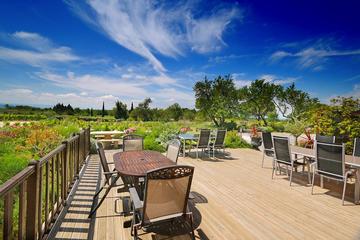
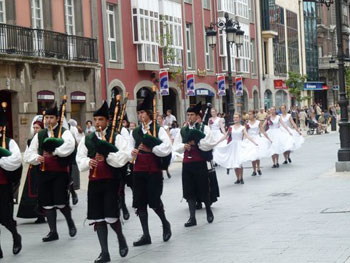
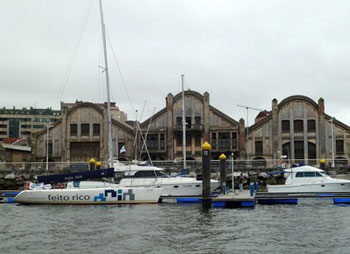 Roman Alvarez Gonzalez is a teacher by profession. We met him during a boat ride along Rio Aviles. Currently he is serving as the Councilor for Culture and Sports in Aviles. Roman’s history 101 lesson includes among other things that Aviles sits on the most northerly tip of Spain and is the third largest city in the Principality of Asturias with 80,000 residents. The natural estuary made it a perfect seaport in the Middle Ages and a key to the salt trade with France, when salt was worth more then gold. Sabugo now a district of Aviles began as a fishing port on the Rio Aviles. In part because of over fishing the fishing industry is no longer a major player in the economy. For a time in the mid 20th century shipbuilding and a steel industry also prospered on the waterfront.
Roman Alvarez Gonzalez is a teacher by profession. We met him during a boat ride along Rio Aviles. Currently he is serving as the Councilor for Culture and Sports in Aviles. Roman’s history 101 lesson includes among other things that Aviles sits on the most northerly tip of Spain and is the third largest city in the Principality of Asturias with 80,000 residents. The natural estuary made it a perfect seaport in the Middle Ages and a key to the salt trade with France, when salt was worth more then gold. Sabugo now a district of Aviles began as a fishing port on the Rio Aviles. In part because of over fishing the fishing industry is no longer a major player in the economy. For a time in the mid 20th century shipbuilding and a steel industry also prospered on the waterfront.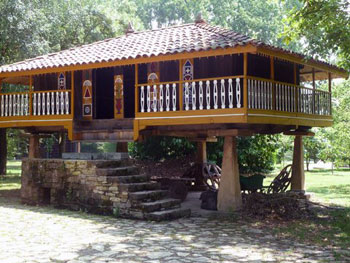 El Café de Joey is in old town Aviles. Joey is Asturian/American and a bit of a history nut. Never reluctant to share his knowledge as he rushes about catering to his customers, Joey tells me over a potato tortilla and cold drink that Aviles was a key to Spain’s exploration for new territory. He points out that the 16th century Spanish explorer Pedro Menedez de Aviles sailed from the walled city to the new world where he founded America’s oldest continually populated city of San Augustin (St. Augustine, Florida). San Augustin is their sister city and their patron saint. While he stops to top up my glass Joey expounds on Asturians in Cuba. Spaniards sailed from Aviles to the Caribbean Island where they were instrumental in developing the island country’s tobacco farming prior to Castro’s regime. El Café de Joey now sits where the medieval cities wall once stood.
El Café de Joey is in old town Aviles. Joey is Asturian/American and a bit of a history nut. Never reluctant to share his knowledge as he rushes about catering to his customers, Joey tells me over a potato tortilla and cold drink that Aviles was a key to Spain’s exploration for new territory. He points out that the 16th century Spanish explorer Pedro Menedez de Aviles sailed from the walled city to the new world where he founded America’s oldest continually populated city of San Augustin (St. Augustine, Florida). San Augustin is their sister city and their patron saint. While he stops to top up my glass Joey expounds on Asturians in Cuba. Spaniards sailed from Aviles to the Caribbean Island where they were instrumental in developing the island country’s tobacco farming prior to Castro’s regime. El Café de Joey now sits where the medieval cities wall once stood.
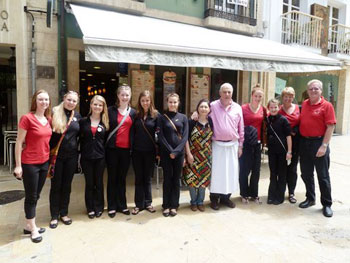 That brings us back to The Beltaine Festival. Celtic music is a big part of Asturian history including bagpipes or gaitas, as they are known in Spain. The Gaiteras are usually accompanied by tamboril (snare drum) and requinta (fife) and folk dancers. The Beltaine Festival attracts Celtic performers from around the Principality of Asturia, Scotland, France, England and this year Juan Carlos took a leap of faith and for the first time invited a Canadian group. From the start of the festival The Inverglen Scottish Dancers performed on the main stage in Parque De La Muelles, in the Plaza De Espana and around the old town to enthusiastic audiences.
That brings us back to The Beltaine Festival. Celtic music is a big part of Asturian history including bagpipes or gaitas, as they are known in Spain. The Gaiteras are usually accompanied by tamboril (snare drum) and requinta (fife) and folk dancers. The Beltaine Festival attracts Celtic performers from around the Principality of Asturia, Scotland, France, England and this year Juan Carlos took a leap of faith and for the first time invited a Canadian group. From the start of the festival The Inverglen Scottish Dancers performed on the main stage in Parque De La Muelles, in the Plaza De Espana and around the old town to enthusiastic audiences.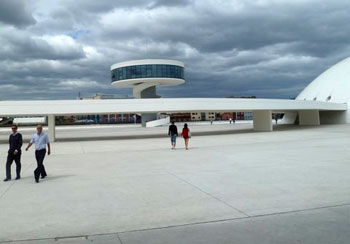 A short train ride away is Gijon, much more touristy then Aviles it is worth a day trip. The Museu del Pueblu d’Asturies preserves the history of the Asturian people and includes a collection of habitats and Horreos from the 17th to 20th century as well as the Asturian Pavilion that was built for the Seville Expo ‘92. It’s well worth a visit. Before catching the train back to Aviles check out the market in Plaza Mayor or just enjoy the sun and sand along Plaza de San Lorenzo.
A short train ride away is Gijon, much more touristy then Aviles it is worth a day trip. The Museu del Pueblu d’Asturies preserves the history of the Asturian people and includes a collection of habitats and Horreos from the 17th to 20th century as well as the Asturian Pavilion that was built for the Seville Expo ‘92. It’s well worth a visit. Before catching the train back to Aviles check out the market in Plaza Mayor or just enjoy the sun and sand along Plaza de San Lorenzo.